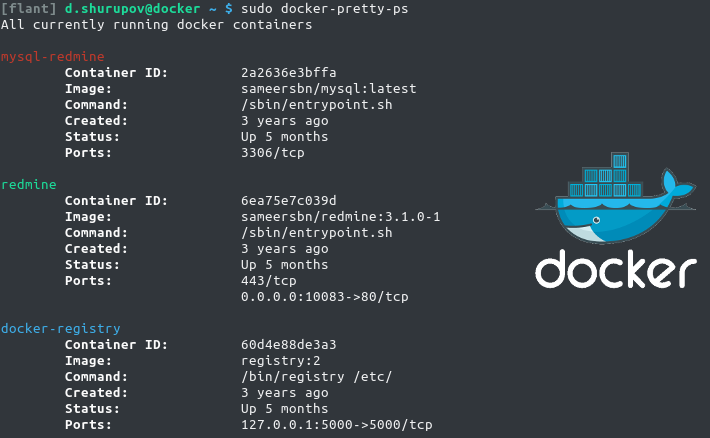docker-pretty-ps - finally convenient for reading “docker ps”
You are not alone in this world, if for a long time you are not happy with what a standard output looks like
The author's idea is utterly banal: horizontal output and colors for clarity.

And as an audience, utilities are called “developers rather than hardcore DevOps or SRE engineers.”
With the appearance of everything should be clear from the picture. What does the utility allow in terms of functions? By default, all running containers are output, but of course the possibilities are not limited to this - in docker-pretty-ps it is supported:
The project code is written in Python and the authors separately note that third-party Python packages are not used, so it’s enough to run Docker and Python in order to start, which is true for many.
Installation is done via pip:
... or just a simple build:
All - you can use:
Despite the widespread support on Reddit, this utility is definitely not for everyone. In particular, if you have many containers (dozens or more), then even using the mode
The formatting option for
argument
(NB: In the example above, the full names of containers and images were cut off manually for better clarity.)
For details on working with
Perhaps even more popular way is to use the ctop utility , which offers an interface similar to the classic one

Its convenient launch in the console can be reduced to such an alias:
In addition, of course, there are others that are more advanced in their capabilities. - interfaces, but their description is beyond the scope of the article. What do you use?
Read also in our blog:
docker ps. Although there are various workarounds on this topic (see the end of the material) , one day some enthusiast had to do “something else” ... and this happened in the ensuing 2019. His name is docker-pretty-ps . The author's idea is utterly banal: horizontal output and colors for clarity.

And as an audience, utilities are called “developers rather than hardcore DevOps or SRE engineers.”
Opportunities
With the appearance of everything should be clear from the picture. What does the utility allow in terms of functions? By default, all running containers are output, but of course the possibilities are not limited to this - in docker-pretty-ps it is supported:
- withdrawal of all containers (including stopped ones);
- Container search pattern:
docker-pretty-ps my,trydisplays containers, which are found in the title*my*and*try*(e.g.,docker-registryandmysql-redmine); - several sorting options;
- customizable display fields for each container (available:
container_id,created,ports,image_id,status,command); - compact output mode
slim(removes all the fields listed above, leaving only the names of the containers):
- output data in JSON format.
Installation
The project code is written in Python and the authors separately note that third-party Python packages are not used, so it’s enough to run Docker and Python in order to start, which is true for many.
Installation is done via pip:
pip install docker-pretty-ps... or just a simple build:
git clone https://github.com/politeauthority/docker-pretty-ps.git
cd docker-pretty-ps
python3 setup.py build
python3 setup.py installAll - you can use:
$ docker-pretty-ps -h
usage: docker-pretty-ps [-h] [-a] [-s] [-i INCLUDE] [-o [ORDER]] [-r] [-j]
[-v]
[search]
positional arguments:
search Phrase to search containers, comma separate multiples.
optional arguments:
…Other workarounds
Despite the widespread support on Reddit, this utility is definitely not for everyone. In particular, if you have many containers (dozens or more), then even using the mode
slimwill not always be convenient. And then one of the well-known workarounds can be more useful.docker ps --format
The formatting option for
docker psis not just workaround, but in a certain sense the best solution, since does not require anything extra in terms of installation in the system. Many Docker commands accept the argument
--format, allowing (via the go-template ) to customize their output for themselves. For the team, docker psits support has appeared a long time ago (in the Docker 1.8 release from August 2015). Here is an example of its use:[flant] d.shurupov@kube-node-test ~ $ sudo docker ps --format 'table {{.Names}}\t{{.Image}}'
NAMES IMAGE
k8s_fluentd_fluentd-jmzjd_loghouse… flant/loghouse-fluentd…
k8s_cert-manager_cert-manager-… quay.io/jetstack/cert-manager-controller…
k8s_prometheus-config-reloader_… 597141b113d9
k8s_prometheus_prometheus-main-… cc866859f8df
k8s_POD_prometheus-main-0_kube-… k8s.gcr.io/pause-amd64:3.1
…(NB: In the example above, the full names of containers and images were cut off manually for better clarity.)
For details on working with
--format, see, for example, this article , and examples of available functions are in the Docker documentation .ctop
Perhaps even more popular way is to use the ctop utility , which offers an interface similar to the classic one
top, but for Docker containers: 
Its convenient launch in the console can be reduced to such an alias:
alias ctop='docker run --rm -ti -v /var/run/docker.sock:/var/run/docker.sock quay.io/vektorlab/ctop:latest'In addition, of course, there are others that are more advanced in their capabilities. - interfaces, but their description is beyond the scope of the article. What do you use?
PS
Read also in our blog:
